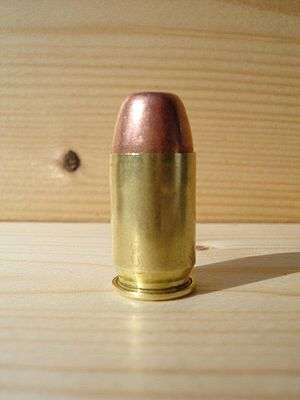.45 GAP
The .45 GAP (Glock Auto Pistol) or .45 Glock (11.43×19mm) pistol cartridge was designed by Ernest Durham, an engineer with CCI/Speer, at the request of firearms manufacturer Glock to provide a cartridge that would equal the power of the .45 ACP, have a stronger case head to reduce the possibility of case neck blowouts, and be shorter to fit in a more compact handgun. GAP is an acronym for "Glock Automatic Pistol", and the .45 GAP is the first commercially introduced cartridge identified with Glock.
| .45 GAP | ||||||||||||||||||||
|---|---|---|---|---|---|---|---|---|---|---|---|---|---|---|---|---|---|---|---|---|
 A .45 GAP cartridge. | ||||||||||||||||||||
| Type | Pistol | |||||||||||||||||||
| Place of origin | Austria United States | |||||||||||||||||||
| Service history | ||||||||||||||||||||
| In service | 2003–present | |||||||||||||||||||
| Production history | ||||||||||||||||||||
| Designer | Ernest Durham | |||||||||||||||||||
| Designed | November 2002 | |||||||||||||||||||
| Manufacturer | CCI/Speer | |||||||||||||||||||
| Produced | 2003–present | |||||||||||||||||||
| Specifications | ||||||||||||||||||||
| Case type | Rimless, straight | |||||||||||||||||||
| Bullet diameter | .451 in (11.5 mm) | |||||||||||||||||||
| Case length | .755 in (19.2 mm) | |||||||||||||||||||
| Overall length | 1.070 in (27.2 mm) | |||||||||||||||||||
| Primer type | Small pistol | |||||||||||||||||||
| Maximum pressure | 23,000 psi (160 MPa) | |||||||||||||||||||
| Ballistic performance | ||||||||||||||||||||
| ||||||||||||||||||||
| Test barrel length: 4.49 in Source(s): DoubleTap Ammo[1] | ||||||||||||||||||||
Development
The .45 GAP has the same diameter as the .45 ACP pistol cartridge but is slightly shorter, and uses a small-pistol primer instead of the large-pistol primer most commonly used in .45 ACP ammunition. Originally, the maximum bullet weight of the .45 GAP was 200 grains (13 g). In order to provide terminal ballistics that matched the standard 230-grain (15 g) .45 ACP loads, the .45 GAP was designed to operate at a higher standard pressure—roughly equivalent to the higher pressures found in .45 ACP "+P" rounds. Since the .45 GAP has a much smaller cartridge volume than the .45 ACP, the desired pressure and resulting velocity needed to be achieved through powder selection alone. Later development concluded that the .45 GAP could also fire 230-grain (15 g) projectiles, as does the .45 ACP; though this pushes the .45 GAP cartridge to its limits.
Glock .45 GAP pistols
The full-size Glock 37 pistol was introduced by Glock to use the .45 GAP cartridge and was followed by the compact Glock 38 and the subcompact Glock 39. Glock's .45 GAP sized pistols use the same frame as their 9×19mm/.40 S&W/.357 SIG line of pistols. The slide is slightly wider to accommodate the larger diameter .45 cal round and is flush with the frame. Magazines for the .45 GAP are of the same dimensions as those that the 9×19mm/.40 S&W/.357 SIG line of pistols use.
Other .45 GAP firearms
Initially, due to its acceptance by law enforcement and the popularity of subcompact handguns for concealed carry, a small number of manufacturers decided to produce pistols that were chambered in .45 GAP, but they no longer produce any pistols in that caliber. Only Glock and Bond Arms continue to manufacture pistols in the 45 GAP cartridge. Springfield Armory, Inc. did make the XD series in .45 GAP, and indeed it was the first commercially available pistol for it, but discontinued that chambering soon thereafter.
Law enforcement application
Modern law enforcement as a whole has gone away from .45-caliber weapons in favor of firearms chambered in .40 S&W and 9x19mm. Despite this change, the .45 GAP has had a following amongst many law enforcement departments. Three state law enforcement agencies have adopted the .45 GAP as a replacement for their current issue 9×19mm Parabellum (New York) or .40 S&W service handguns (South Carolina and Florida). The New York State Police, (New York Police have recently completed the transition to 45 ACP for their duty round) South Carolina Highway Patrol, and Florida Highway Patrol[2] have all adopted the Glock 37 and .45 GAP. However, in May 2020 the Florida Highway Patrol announced that they will adopt the Glock 45 MOS and Glock 43X as new Duty Weapons, which will replace the Glock 37 and 39.
Smaller agencies also applied the .45 GAP for duty carry such as the Burden, Kansas, Police Department who carry the Glock 37 and serve a town of 535. The Greenville, North Carolina, Police Department used the Glock 37, and the Berkeley, Missouri, Police Department also used the Glock 37, to name a few.
The Georgia State Patrol carried the Glock Model 37, but has since moved to the fourth generation 9x19mm Glock 17. The South Carolina Highway Patrol also abandoned the Glock 37, but they chose the newer Glock 17 "M" chambered in 9mm.
The Pennsylvania State Police also carried the Glock 37 from 2007, but, due to ammunition supply problems, replaced them in 2013 with the then-new fourth generation Glock 21 in .45 ACP. After recall issues with the new fourth generation Glocks, the Pennsylvania State Police switched to the SIG-Sauer P227 in .45 ACP.[3]
See also
References
- "DoubleTap Ammo .45 GAP page". Archived from the original on 2009-04-20. Retrieved 2009-06-18.
- Unique Gen 4 Glock in .45 GAP for Florida Highway Patrol
- http://weaponsman.com/?p=16496
External links
| Wikimedia Commons has media related to .45 GAP. |